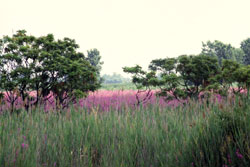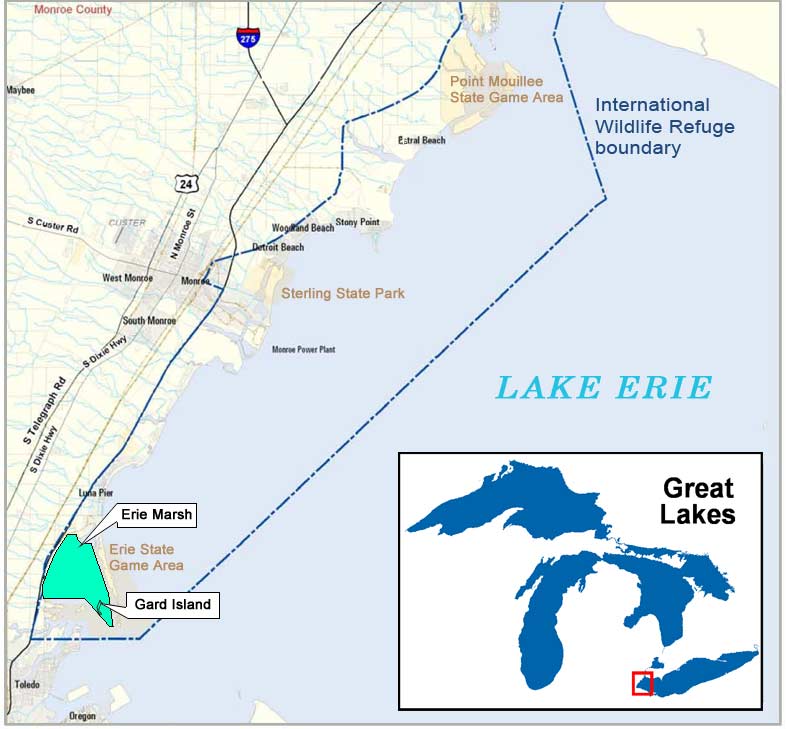Detroit River-Western Lake Erie Basin Indicator Project
Invasion of the Erie Marsh Preserve by Common Reed (Phragmites australis)
Background
Coastal marshes and other wetlands in the western Lake Erie basin once covered about 4,000 km2 (988,000 acres; Herdendorf 1987), but over the last approximately 150 years, more than 95% of the coastal marshes have been drained or converted to other uses (Herdendorf 1992). Draining of the marshes, hardening and armoring of shorelines, and other changes in land use have substantially altered the normal movement of marsh vegetation lakeward or landward in response to fluctuating lake levels (Gottgens et al. 1998). These coastal wetlands provide many benefits, including stabilizing and maintaining the water table, providing flood control, providing erosion protection, serving as living filters of nutrients and sediments, aiding in groundwater recharge, providing wildlife habitat, and offering recreational opportunities.
Compounding this loss of coastal marshes is the recent and dramatic invasion by nonnative plant species such as purple loosestrife (Lythrum salicaria) and narrow-leaved cattail (Typha angustifolia). Common reed (Phragmites australis) is also one of the biggest threats to native wetlands. While there is a native type, this more aggressive genetic type originates elsewhere. Invasion by these nonnative forms of common reed has caused the plant to become dominant in many wetlands of western Lake Erie, especially on the U.S. shoreline. It is still expanding into new areas and out-competing native types of the plant because of physiological and behavioral advantages, and threatens the proper functioning of native wetland ecosystems. Common reed grows up to 12 feet in height, can shade out shorter native plants, decreases biological diversity, and degrades marsh habitat (Figure 1).

Figure 1. Common reed (Phragmites australis) and purple loosestrife (Lythrum salicaria) at Erie Marsh (Photo credit: The Nature Conservancy Photo Archives).
The Erie Marsh Preserve, located in North Maumee Bay on the western shore of Lake Erie (Figure 2), is a 2,217 acre preserve owned by The Nature Conservancy and managed in partnership with the Erie Shooting and Fishing Club. The preserve is now part of the Detroit River International Wildlife Refuge by virtue of a cooperative management agreement between the U.S. Fish and Wildlife Service and the Conservancy. Since first establishing the preserve in the 1870s, the Club has managed the marsh to maximize production of waterfowl. The Club generously donated the preserve to the Conservancy in 1978 and continues to lease the hunting rights and actively manage a central diked area of about 900 acres.

×
![]()
Figure 2. Location of the Erie Marsh Preserve in western Lake Erie (click the map for a larger version)
Erie Marsh is a globally important stopover site for migrating waterfowl, land birds, and shorebirds, is home to the state-threatened Eastern fox snake (Elaphe vulpina gloydi), and is a breeding area for bald eagles. Invasive species compromise or eliminate the value of coastal marshes as bird stopover sites and as habitat for common and rare animals. In the last two decades, the marsh has undergone severe invasion by common reed.
Status and Trends
Vegetation in the marsh was relatively stable from the early part of the century until the early 1970s (Hunt and Mickelson 1976). Over this period, the marsh was characterized by "large stands of cattail, spike rush (Eleocharis) in the low areas, roundstem in the transition from water to marsh land, clumps of willow on high ground, thistles and weeds on the dikes, and bodies of shallow water with muddy bottom" (Douglass 1934, as reported by Pirnie and Foster 1964). Common reed has been present in the marsh for at least 50 years and presumably as long as there have been coastal marshes. Only recently has it been confirmed through genetic analysis that there are native types of common reed in North America (Saltonstall 2002). It was reported at low densities in the 1950s, though it is not clear whether the plants were native or nonnative types (Hunt 1957). Native types were first found at Erie Marsh in 2004 and it is unclear the degree to which cover of native common reed varieties have diminished as nonnative types have taken over. It is unclear exactly when common reed began to expand to become the dominant plant that it is today because even in reports from the early and mid-1980s, common reed was mentioned only as an associate to cattail and native marsh plants.
An assessment of aerial photographs from 1984 to 2003 indicates a dramatic increase in the coverage of common reed. In the 1984 photographs there are no clearly distinguishable invasive types of common reed. Conservative interpretation of the 1998 and 2003 imagery reveals at least 72 hectares (180 acres) and 132 hectares (325 acres) of invading common reed in those years, respectively (Table 1). Although data from intervening years would be instructive in terms of the rate of expansion, it is clear from these few data points that the expansion is proceeding more quickly toward the end of this period than in the beginning, and is showing the characteristic exponential growth of many invasive species.
Table 1. Area of dense coverage of common reed at the Erie Marsh Preserve.


Management Next Steps
It is imperative that we protect the biological integrity of the Detroit River and western Lake Erie coastal wetlands since they hold great diversity of species. Indeed, the Detroit River and western Lake Erie are one of twenty Biodiversity Investment Areas identified by EPA and Environment Canada through the State of the Lake Ecosystem Conference.
The Nature Conservancy is working with the Erie Shooting and Fishing Club, Ducks Unlimited, and the U.S. Fish and Wildlife Service on a habitat management plan for Erie Marsh. Currently, managers are implementing a combined program of herbicide application, flooding, and prescribed fire to restore large areas to native vegetation. Upon completion of the management plan for Erie Marsh, additional management actions will be taken through this partnership.
Research/Monitoring Needs
Continued emphasis needs to be placed on surveys, monitoring, and research. The data and information generated from these surveys, monitoring programs, and research projects will be used to foster an adaptive management approach at Erie Marsh where management priorities are set, actions taken, and surveys and monitoring undertaken in an iterative fashion for continuous improvement.
Moreover, Erie Marsh may be a reasonable indicator of marshes that are being managed by public and private organizations, but perhaps not a good indicator of the extent or trend in coverage of common reed across the entire western Lake Erie basin. The costs, benefits, and feasibility of a basin-wide monitoring effort through remote-sensing techniques are worth exploring, especially as managers invest increasing amounts of resources into control efforts.
References
- Gottgens, J.F., B.P. Swartz, R.W. Kroll, and M. Eboch. 1998. Long-term GIS-based records of habitat changes in a Lake Erie coastal marsh. Wetlands Ecology and Management 6:5-17.
- Herdendorf, C.E. 1987. The ecology of the coastal marshes of western Lake Erie: A community profile. U.S. Fish and Wildlife Service Biological Report 85 (7.9).
- Herdendorf, C.E. 1992. Lake Erie coastal wetlands: An overview. Journal of Great Lakes Research 18:533-551.
- Hunt, G.S.1957. Report of surveys on the Erie Shooting Club Area. Erie Research Committee.
- Hunt, G.S., and P.G. Mickelson. 1976. Ecological studies at the Erie Shooting and Fishing Club marsh and their management implications, Monroe County, MI. Erie Research Committee.
- Pirnie, M.D., and J. Foster. 1964. Report of Erie researches, 1960 through 1963. Erie Research Committee & Wildlife Management Foundation.
- Saltonstall, K. 2002. Cryptic invasion by a non-native genotype ofthe common reed, Phragmites australis into North America. Proceedings of the National Academy of Sciences, USA. 99(4):2445-2449.
Contact Information regarding Invasion of the Erie Marsh Preserve by Common Reed (Phragmites australis)
Doug Pearsall
The Nature ConservancyE-mail: dpearsall@tnc.org
Barry Muller
DTE EnergyE-mail: mullerb@dteenergy.com